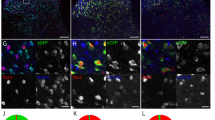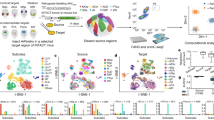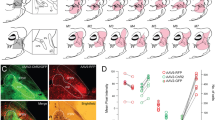Abstract
The peripheral receptive properties and central projections of different classes of dorsal root ganglion neurones are well characterized1,2. Much less is known about the transmitters used by these neurones. Excitatory amino acids have been proposed as sensory transmitters3 but the sensitivity of virtually all central neurones to those compounds has made it difficult to assess their precise role in sensory transmission. Several neuropeptides have been localized within discrete subclasses of primary sensory neurones that project to the superficial dorsal horn of the spinal cord4–7 and may be afferent transmitters. However, only about one-third of spinal sensory neurones have been shown to contain neuropeptides8. We have recently described the presence of a 5′-nucleotide hydrolysing acid phosphatase in a separate subpopulation of dorsal root ganglion neurones that project to the superficial dorsal horn44. This enzyme also appears in certain autonomic and endocrine cells that contain high concentrations of releasable nucleotides in their storage granules9–13. It is possible that the presence of this enzyme in sensory neurones is also associated with a releasable pool of nucleotides. Holton and Holton have provided evidence that ATP is released from the peripheral terminals of unmyelinated sensory fibres14 and have suggested that release of ATP might also occur from central sensory terminals. To investigate the possibility that nucleotides act as central sensory transmitters we have examined their actions on rat dorsal horn and dorsal root ganglion neurones maintained in dissociated cell culture. We report here a selective and potent excitation of subpopulations of both neuronal types by ATP.
This is a preview of subscription content, access via your institution
Access options
Subscribe to this journal
Receive 51 print issues and online access
$199.00 per year
only $3.90 per issue
Buy this article
- Purchase on SpringerLink
- Instant access to full article PDF
Prices may be subject to local taxes which are calculated during checkout
Similar content being viewed by others
References
Burgess, P. R. & Perl, E. R. in Handbook of Sensory Physiology Vol. II (ed. Iggo, A.) 29–78 (Springer, New York, 1973).
Brown, A. G. Organization in the Spinal Cord (Springer, New York, 1981).
Curtis, D. R. & Johnston, G. A. R. Ergebn. Physiol. 69, 97–188 (1974).
Hökfelt, T. Neurosci. Res. Program Bull. 17, 425–443 (1979).
Fuxe, K., Ganten, D., Hökfelt, T. & Bolne, P. Neurosci. Lett. 2, 229–234 (1976).
Dalsgaard, C. J. et al. Neurosci. Lett. 33, 159–163 (1982).
Panula, P., Hadjiconstantinou, M., Yang, H. Y. T. & Costa, E. Soc. Neurosci. Abst. 8, 135 (1982).
Jessell, T. M. in Brain Peptides (eds Krieger, D. T. et al.)(Wiley, New York, in the press).
Smith, A. D. & Winkler, H. Handbk exp. Pharmac. 33, 538–617 (1972).
Stjarne, L. Handbk exp. Pharmac. 33, 231–269 (1972).
Von Euler, U., Lishajko, F. & Stjarne, L. J. Acta physiol. scand. 59, 495–496 (1963).
Leitner, J. W., Sussman, K. E., Vatter, A. E. & Schneider, F. H. Endocrinology 95, 662–677 (1975).
Douglas, W. H. & Poisner, A. M. J. Physiol., Lond. 183, 249–256 (1966).
Holton, F. A. and Holton, P. J. Physiol., Lond. 126, 124–140 (1954).
Galindo, A., Krnjevic, K. & Schwartz, S. J. Physiol., Lond. 192, 359–377 (1967).
Furshpan, E. J., Potter, D. D. & Landis, S. C. Harvey Lect. 76, 149–191 (1981).
Burnstock, G. J. theor. Biol. 62, 491–503 (1976).
Hooper, M., Spedding, M., Sweetman, A. J. & Weetman, D. F. B. J. Pharmac. 50, 458P–459P (1974).
Barker, J. L. & Ransom, B. R. J. Physiol., Lond. 280, 331–354 (1978).
Sonnhof, V. & Bührle, Ch. in Glutamate as a Neurotransmitter (eds DiChiari, G. & Gess, G. L.) 195–204 (Raven, New York, 1981).
Lotan, L., Dascal, N., Cohen, S. & Lass, Y. Nature 298, 572–574 (1982).
Yatari, A., Tsuda, Y., Akaike, N. & Brown, A. M. Nature 296, 169–171 (1982).
Siggins, G. R., Gruol, D. L., Padjen, A. L. & Forman, D. S. Nature 270, 263–265 (1982).
Akasu, T., Hirai, K. & Koketsu, K. Brain Res. 258, 313–317 (1983).
Gallagher, D. V. Nature 296, 83–86 (1982).
Sneddon, P., Westfall, D. P. & Fedan, J. S. Science 218, 693–695 (1982).
Loubatiers, A. L., Loubatieres-Mariani, M. M. & Chapal, J. C.r. Soc. Biol. Acad. Sci., Paris 166, 1742–1746 (1972).
Wier, G. C., Knowlton, St D. & Martin, D. B. Endocrinology 97, 932–936 (1975).
Chapal, J. & Loubatieres-Mariani, M. M. Br. J. Pharmac. 73, 105–110 (1981).
Yamamoto, M., Steinbusch, H. M. W. & Jessell, T. M. J. Cell Biol. 91, 142–152 (1981).
Phillis, J. W. & Kirkpatrick, J. R. Gen. Pharmac. 9, 239–247 (1978).
Salt, T. E. & Hill, R. G. Neurosci. Lett. 35, 53–57 (1983).
Curtis, D. R., Phillis, J. W. & Watkins, J. C. J. Physiol., Lond. 158, 296–323 (1961).
Stone, T. W. Neuroscience 6, 523–555 (1981).
Burnstock, G. J. Physiol., Lond. 313, 1–35 (1981).
Holton, P. J. Physiol., Lond. 120, 95–104 (1953).
Holton, P. J. Physiol., Lond. 145, 494–504 (1959).
Celander, O. & Folkow, B. Acta physiol. scand. 29, 359–370 (1953).
Poisner, A. M. & Trifaro, J. M. The Secretory Granule (Elsevier, Amsterdam, 1982).
Otsuka, M. & Konishi, S. Cold Spring Harb. Symp. quant. Biol. 40, 135–143 (1976).
Lembeck, F. and Gamse, R. Ciba Fdn Symp. 91, 35–54 (1982).
Rosell, S., Olgart, L., Grazelius, B., Panopoulos, P., Folkers, K. & Hong, J. Acta physiol. scand. 111, 381–383 (1981).
Fedan, J. S., Hogaboom, G. K., Westfall, D. P. & O'Donnell, J. P. Eur. J. Pharmac. 81, 193–204 (1982).
Dodd, J. et al. Cold Spring Harb. Symp. quant. Biol. 48 (in the press).
Krishtal, O. A., Marchenko, S. M. & Pidoplichko, V. I. Neurosci. Lett. 35, 41–45 (1983).
Author information
Authors and Affiliations
Rights and permissions
About this article
Cite this article
Jahr, C., Jessell, T. ATP excites a subpopulation of rat dorsal horn neurones. Nature 304, 730–733 (1983). https://doi.org/10.1038/304730a0
Received:
Accepted:
Published:
Issue date:
DOI: https://doi.org/10.1038/304730a0
This article is cited by
-
Triggering of Major Brain Disorders by Protons and ATP: The Role of ASICs and P2X Receptors
Neuroscience Bulletin (2023)
-
The Role of ATP Receptors in Pain Signaling
Neurochemical Research (2022)
-
ATP signaling in the integrative neural center of Aplysia californica
Scientific Reports (2021)
-
Purinergic signalling in spinal pain processing
Purinergic Signalling (2021)
-
Geoffery Burnstock’s influence on the evolution of P2X3 receptor pharmacology
Purinergic Signalling (2021)



